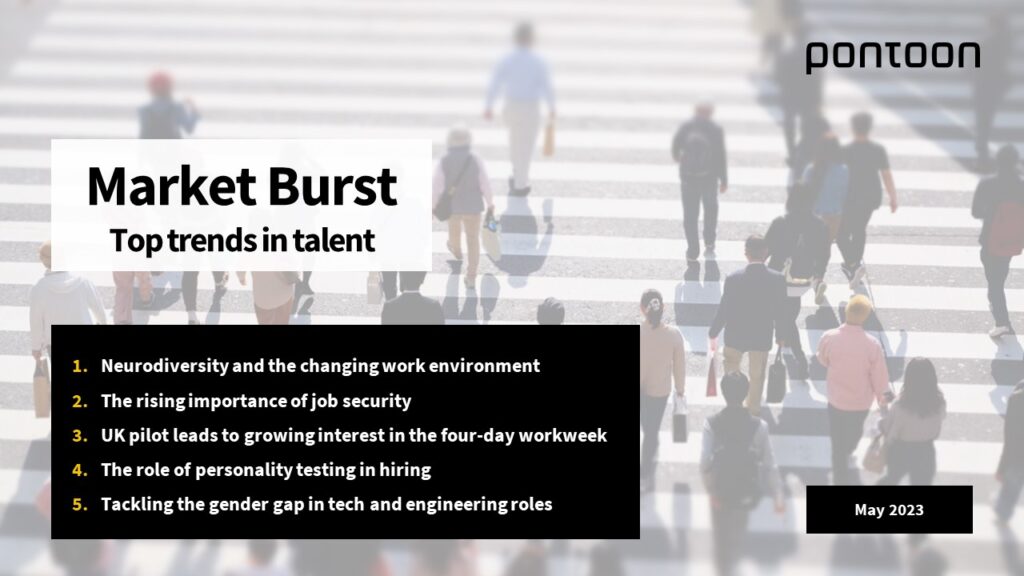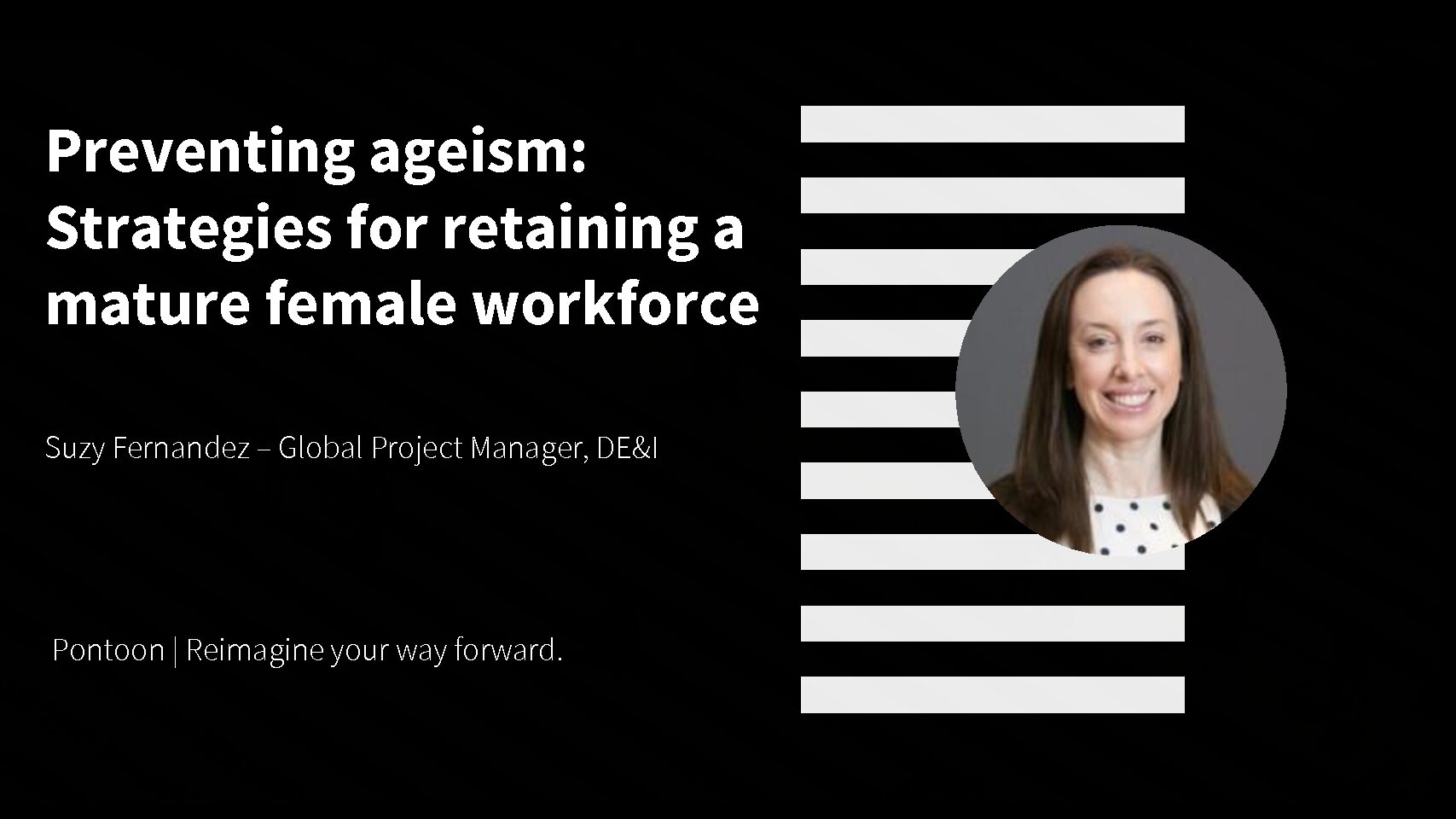Market Burst: May 2023
Read about top trends in the world of work.
In this month’s instalment of our Market Burst, we dive into the trends that continue to drive talent management in the evolving workspace. These include neurodiversity in the workplace, the role of personality testing in hiring, tackling the gender gap in tech and engineering, and more.
Neurodiversity and the changing work environment
Neurodiversity is a rapidly growing area of focus for business leaders in 2023, with an estimated one-fifth (20%) of the global population falling into this category.
Neurodivergent workers, whose conditions are often invisible and typically misunderstood, possess qualities crucial in the new world of work. They are highly creative, think outside the box, and are stronger than average in understanding patterns, evaluating possibilities, and making decisions. Firms willing to enable neurodivergent individuals to reach their full potential unlock great opportunities for innovation within their organisations.
Employers can make numerous accommodations to support and enable neurodiverse workers. These may include providing flexible working hours, offering alternative spaces for work, and providing training on communication and social skills.
It is crucial to create an inclusive environment that allows neurodiverse workers to have their voices heard rather than be judged or excluded. Employers should strive towards a culture of open dialogue, encouraging their talent to come forward about any challenges or concerns regarding their roles and performance.
It is helpful to provide access to support networks and resources, such as mental health services or career transition programmes, which allow individuals with neurological differences to understand their conditions better and learn how they can be turned into advantages at work.
“Attracting all types of talent should be a top priority if we want to make the future work for everyone. A form of autism might make it harder for someone to socialise and connect – but it is in no way related to lower productivity.” Beatrice Kohler – European Midmarket Business Lead, Pontoon
The rising importance of job security
In 2023, we see a continuation of layoffs in the tech industry, with thousands of jobs cut at companies worldwide, including big names such as Microsoft, Yahoo and Zoom. Reports show that the total positions reduced in the sector so far in 2023 (168,243) already exceed the total number of tech layoffs in 2022.
Reductions in workforce significantly impact those who remain in the organisations. Nearly 9 in 10 HR leaders say their workers are expressing concerns about job security, with those based remotely experiencing a 32% higher likelihood of anxiety following layoffs compared to in-office workers. Surging prices and inflation over the last year add to the pressure, with 82% of middle-class families dipping into existing savings to cope with the higher cost of living. Almost 5 in 10 workers surveyed in Pontoon’s Global Workforce of the Future report agree that economic uncertainty will make it a lot harder to find jobs in the future.
Despite people being more careful with switching jobs now, organisations need to double down on strengthening their talent retention strategies. Better career development, upskilling, reskilling, and internal mobility opportunities are proven ways to impact workers’ willingness to stay. This is not the time for firms to think that just because external circumstances are unstable, people will keep up their motivation and productivity levels, irrespective of work conditions. Employers should be wary of resenteeism, as workers remain in organisations but feel unfulfilled and stuck in their jobs.
UK pilot leads to growing interest in the four-day workweek
Now that the research stage of the UK’s 4 Day Week pilot has ended, the results paint an overwhelmingly positive picture of a shorter workweek. Data from the trial shows that productivity and business performance scored positively, with 92% of companies opting to continue with the initiative. Revenue increased by 1.4% on average, and employee turnover dropped by 57%.
Results show that employees were also happy with the scheme — 9 in 10 wanted to continue working on a shorter schedule, with 71% reporting lower levels of burnout.
Many companies, especially in the tech sector, are already leading the way by introducing shorter workweeks. Interestingly, it’s not only tech startups that see the importance of this solution in driving talent engagement and retention. For example, Panasonic now allows workers to take a three-day weekend.
Firms in competitive areas such as tech can’t overlook the promising data on the benefits of a four-day workweek or ignore the long-term implications of the current move in that direction. This may be a much-needed answer for tackling worker burnout and mental health issues, as well as boosting employee retention in an increasingly competitive job market. Employers can experiment with mixed arrangements to sense-check what works best for their organisations before introducing a company-wide scheme. One example is to offer shorter workweeks to project-based employees while keeping other roles on a five-day schedule to start.
The role of personality testing in hiring
In the UK, 43% of employers use psychometric tests during the initial recruitment stage, with the global personality testing industry currently estimated to be worth around $2 billion. Assessments vary significantly in quality, from free online tests to costly, professionally developed surveys used by major employers. Combining these with interviews may result in better job performance predictions than relying solely on academic records or previous experience. However, with over 2000 personality tests on the market, only a handful have any research behind them. In addition, industry experts warn that relying too heavily on personality testing can lead to stalled diversity hiring and should be considered as just one lens in the recruitment process.
Employers must ensure the scientific reliability and appropriateness of the personality tools they use in hiring. Any such tests must be explicitly geared to personnel selection and validated for hiring cases. Misuse or bias during the interpretation of test results can lead to ineffective or discriminatory practices, which can undermine firms’ inclusion goals. If chosen appropriately, personality tests can support identifying candidates likely to perform well in specific roles — and, more importantly, stick around for longer. Still, recruiters shouldn’t rely solely on this type of assessment, as they risk hiring a person with a great personality but lacking the necessary skills or, on the contrary, rejecting a candidate with excellent potential only because their traits don’t match certain expectations.
Tackling the gender gap in tech and engineering roles
Women represent less than one-third of the STEM workforce, and reports suggest that many may soon drop these careers. Female talent in tech and engineering roles are nearly twice as likely as women in other industries to consider leaving the workforce due to stress, burnout, pay disparity, lack of purposeful work, and insufficient diversity.
Research shows that gender gaps are more significant in fast-growing, high-paying roles like computer science and engineering. Key factors perpetuating the gap in this sector include gender stereotypes, male-dominated cultures, and a lack of female role models. Reports reveal that 70% of women in scientific fields feel their employers value male colleagues more.
Firms can tackle the gender gap in STEM by implementing increased flexibility, career progression opportunities, and a diverse and inclusive workplace. The factors contributing to a lack of women in certain industries won’t change overnight, but companies can develop grassroots programmes like mentorships or collaborations with schools, universities, and non-profits. Showcasing success stories of women professionals could contribute to retaining current talent and making sure younger generations of women know they have the option to pursue a career in this field.
“Organisations that can break down the traditional, hierarchical barriers to entry for female STEM talent will reap rewards in the areas of innovation and profits.” Christine Tripp, Director of Operational Excellence
Related Post
We are all living much longer. The idea of a three-stage life – education, work, and retirement – is becoming outdated in today’s Open Talent Economy. Whilst many workers choose ...





